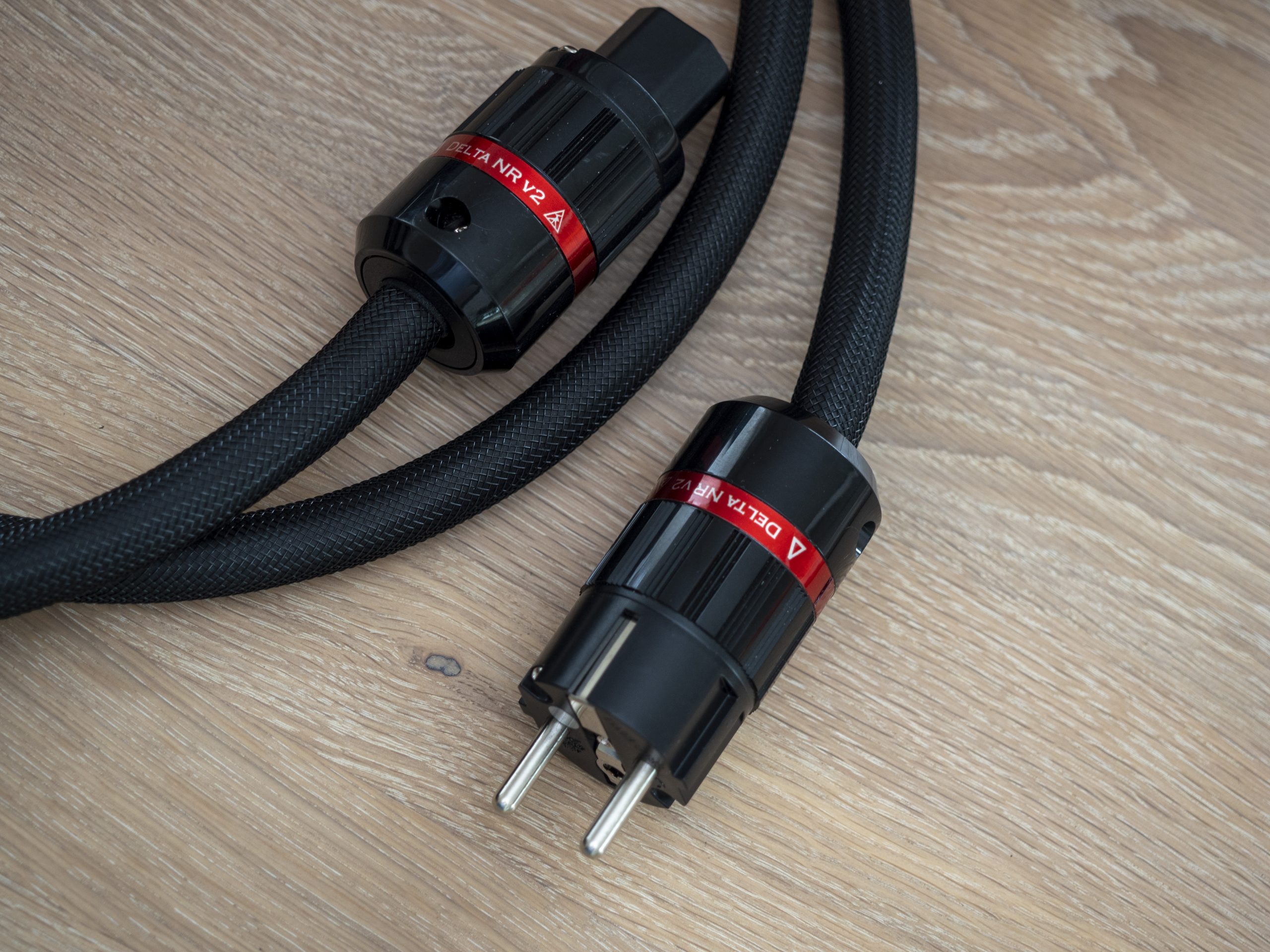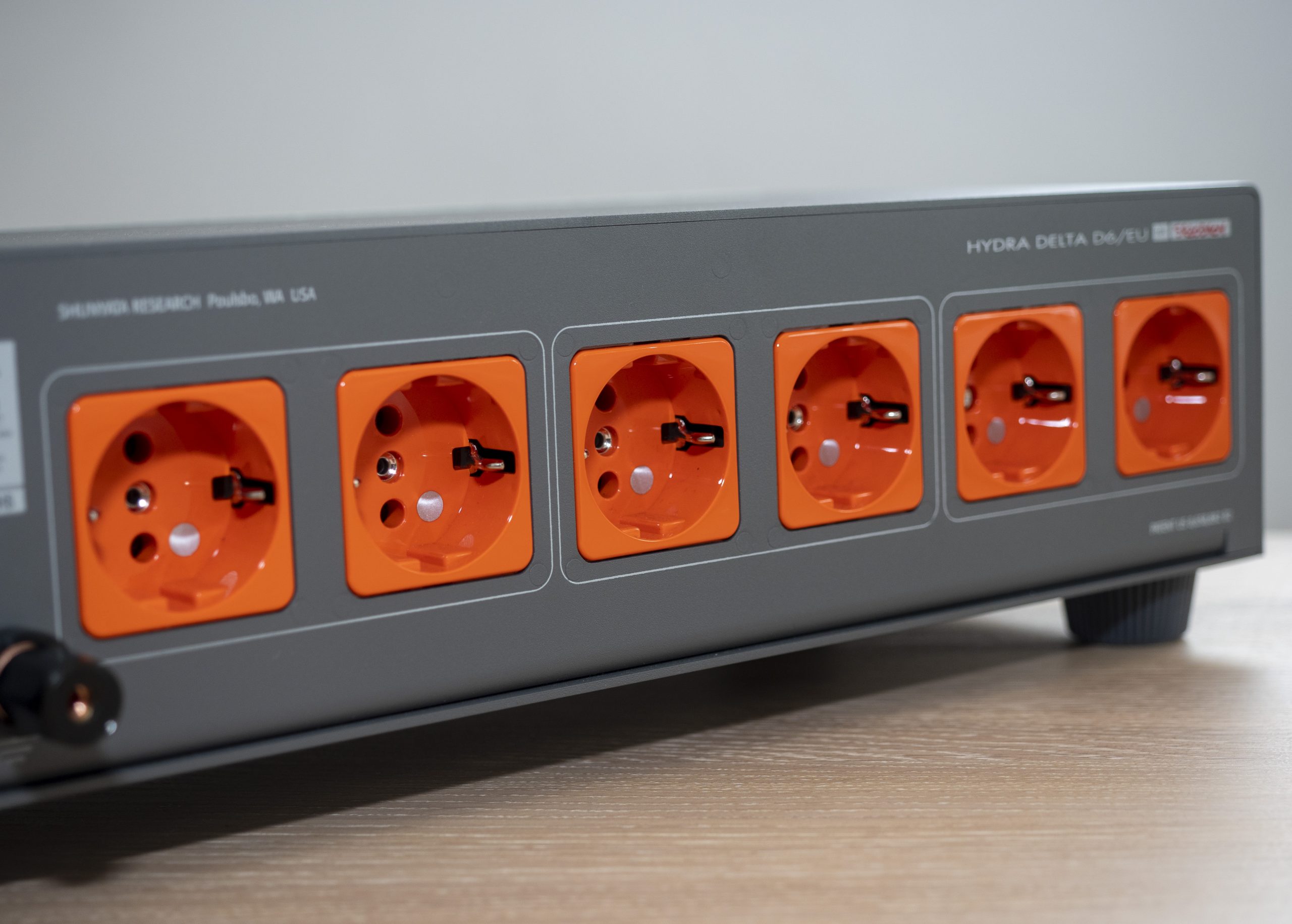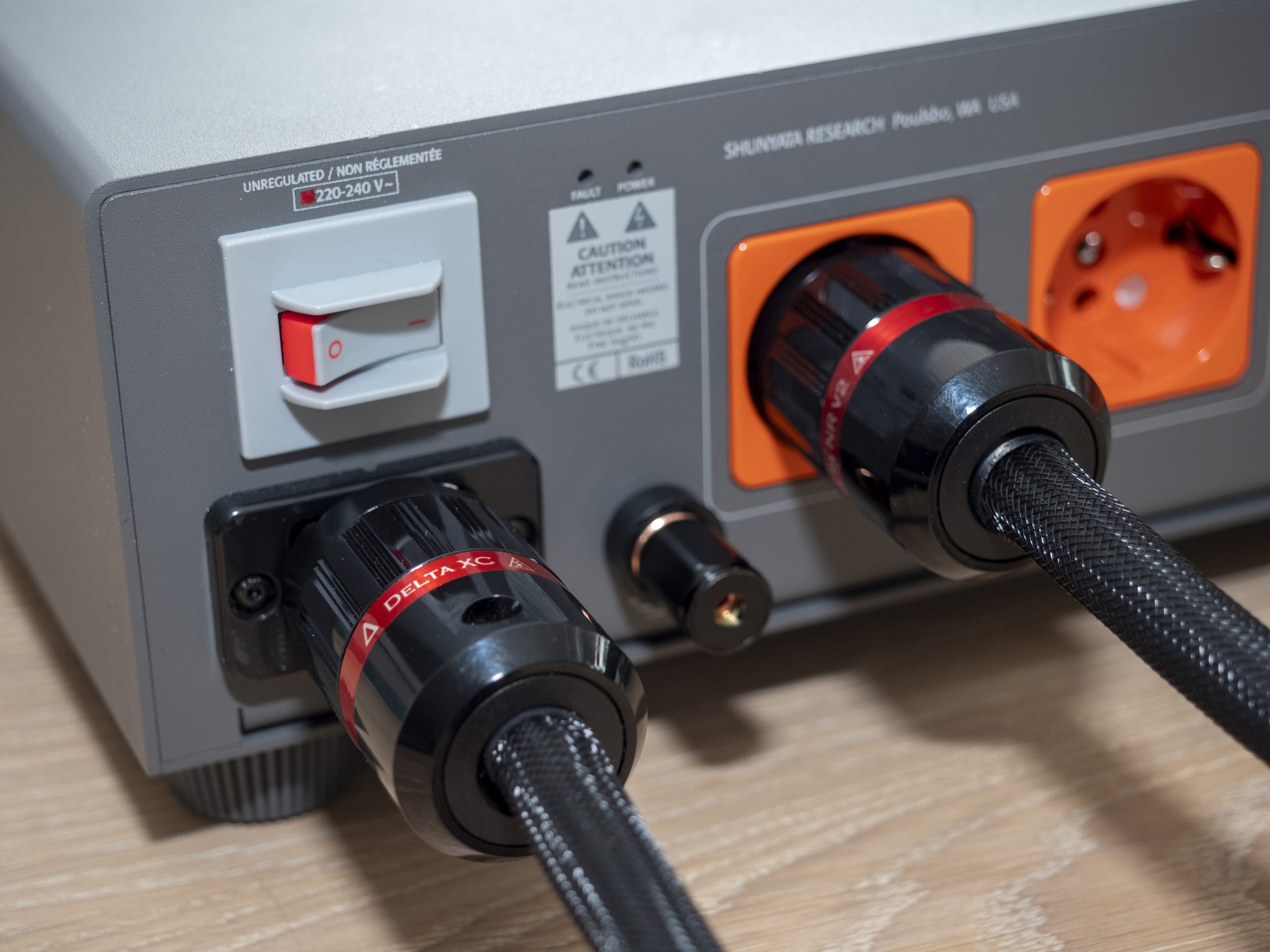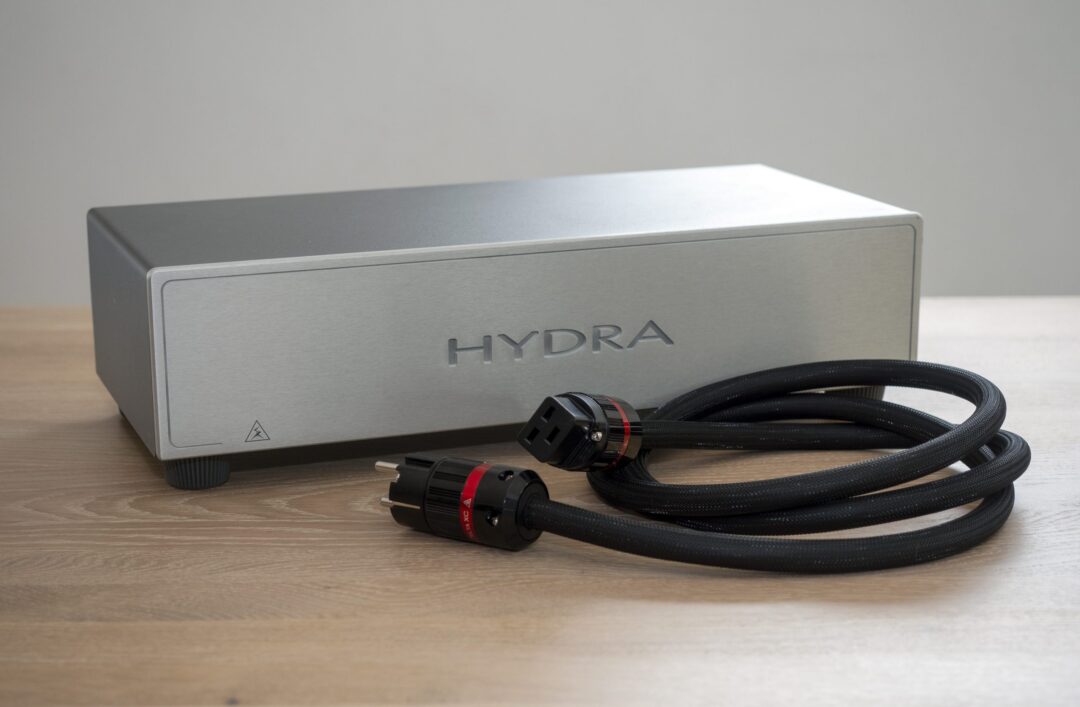We looked at each other, Geir’s look could not be mistaken. This was not what he wanted. I let go of a quiet “f…” that none of us heard, and thought This Is Going To Be Expensive. It will. At least if you are going to have six power cables in addition to a main power cable, and a Shunyata Hydra Delta D6.
Which is a power outlet slash mains filter with six outlets, wrapped in a box that looks like an amplifier.
Actually, it is more than a power outlet. The Hydra Delta box is also a power conditioner in the sense that it attenuates high-frequency noise up to 50 dB according to Shunyata, and at the same time it can remove most of the interference that can occur when connected components send noise back via the power cable.
It may seem like voodoo to many of us, that one can improve the sound by connecting a box to the power outlet in the wall, but Shunyata believes that they can prove with measurements, how impure power and all the influences other devices in the power grid can have on the sound quality.
Shunyata does not only make power outlets like the Hydra Delta box. Clear Image Scientific is a sister company that operates cables and power control for medical devices, where it is fundamentally important that one can read data such as heart rate without interference or noise on the signal.
Therefore, several of Shunyata’s power cables are almost identical to the CIS products used by hospitals, only pulled with a black sock on the outside.
Shunyata believes that what applies to medical devices can be transferred to amplifiers and audio sources, and makes a number of power cables. power outlets and signal and speaker cables in the high-end class

For this is really high-end. The Hydra Delta box and Shunyata’s associated power cables have not been dreamed up, they have according to themselves been developed with objective measurements, and this has led to several patents on the technology and construction of both the cables and the power box.
The technology behind the noise reduction of connected devices is called CCI (Component-to-Component Interference), while the technology behind the reduction of high-frequency noise is called NIC (Noise Isolation Chamber). There is of course much more, such as GP-NR, noise attenuation of power from the mains, and extensive use of damping materials that dampen vibrations, conductors of OFE C10100 copper, electromagnetic and hydraulic surge protection, and the power box can be equipped with additional damping feet in stainless steel.
Ideally, the box should be on a shelf, separated from the floor, says Daniel Månsson at the importer Audionord.
We tried both, but before we got that far, we connected a Hegel H360 and a CD player, to the power outlet in our test room, with generic, black earthed power cables.
The same ones you find in the box when you unpack a new product.

More than a subtle difference
After repeating different music tracks, we replaced the black standard cable for the amplifier with a Shunyata Delta NR V2, which is a relatively expensive, grounded power cable with the same type of OFE C10100 copper used in the power box, copper connectors also in the connector, and silver conductors in the center of the cable, which are surrounded by a copper sheath with fluorocarbon as insulation.
The black cable got us both all the way from the chair seat. What black magic was this? We have tested power cables before. Geir has tested and written about power cleaning, and we both remember the time we took a cheap micro system and replaced both power cable and speaker cables, for a veritable chin drop.
The same thing happened here. But the differences were not as subtle. Instead, the solitary Shunyata cable caused the music to grow in scale, and it tightened and bassed, improving the dynamic contrast, and grinding away small sibilants in the soundscape.

We switched back to the regular power cable, and although it definitely sounded really good with it too, we missed the resolution and the peace the Shunyata cable gave us. So we switched again. And listened again, and again. There was no doubt. The expensive cable lifted the music out of the box, so to speak, and released it into the room.
On the one hand, it was a relief. This is despite being expensive. On the other hand, it was not quite what we had hoped for, because we both knew that if the differences were noticeable, we would want to cable up the entire facility with the cables from Shunyata. That would be expensive, that.
Therefore, it was with horror-mixed joy that we connected the Delta NR V2 cable to the power box, which in turn was connected to the mains with another Shunyata cable. A Delta XC with the larger C19 connector, which is not included, but is an optional extra for the Hydra Delta box.
Nirvana
If one power cable could give us such large subjective differences in sound quality, then what could two power cables and the Hydra Delta box accomplish?
A rather startling improvement in the sound is the answer.

What had been a positive experience of an audible upgrade of everything in the soundscape, suddenly moved up to a higher division. It seemed as if the big Sonus faber speakers disappeared into thin air, and the room expanded. The piano sound hung powerfully in the middle of the room, and vocals flowed weightlessly around while the bass dynamics nailed us to the Ekornes chairs.
We looked at each other again, Geir waved his arms, and I sank resignedly into the orange chair. Faen.
Geir’s comment
Sitting and listening to power cables and mains filters is something I strongly refuse. Both me and the editor were quite skeptical when we rigged ourselves in the test room, and we were determined that if the differences were marginal, then we should not write about it but let it go by in silence.
But the differences were not marginal. They were rather quite dramatic. It was weird how a recording of Kari Bremnes went from sounding really good through Hegel H360 and Sonus faber Olympica III, to the sound grew to become gigantic when the power equipment from Shunyata was connected.
The great reverberation around Bremnes suddenly stretched well up and out, while the background turned pitch black. I myself mostly sat in a seat a little to the side in the middle, and with the usual, black power cables right in the socket, I heard most from the right speaker, and there was no particular holography to speak of. But with the Shunyata cables and the mains filter, the sound image left the speakers and instead hung weightlessly in the room in front of me.
At first we were a little in doubt whether it could really be true, but when we connected back to the usual power cables, the sound image in front of us collapsed. What we first thought sounded very good, had now become dull and gray.
I had a bit of the feeling that it would be like this, after my own experiences with the affordable web filter EVO3 Corvus from IsoTek. But it is still a bit annoying to state that it should have so much to say. On the one hand, it’s always fun to hear a new layer of details for the first time. But it’s really the most annoying. This is a wasp nest I could have been without.
Conclusion
After a few weeks with the cables and mains filter from Shunyata, we are inclined to claim that an upgrade of the plant should start with the power. I have heard greater acoustic improvements with power cables and power filters than I have heard from speaker cables. Which again turns out to be repeated in the test of the Shunyata Hydra Delta D6, and the Delta XC and NR V2 cables. You can go a long way in improving the sound with just one power cable, but if you want to lift both the sound quality – and the expenses – to the sky, the Hydra Delta D6 box can do wonders for a system.

We think
Significant improvement of the sound throughout the felt. Six 230 V outputs are enough for an entire system. Terribly expensive.
3500 €
Specifications
- Type: Power filter 230 V
- Connections: 6 x CEE 7/3 16A
- Input: C19R IEC 16 A
- Dimensions, H x D x W: 11.7 x 22.9 x 43.2 cm
- Weight: 4.3 kg
- Other: Hydraulic magnetic surge protection, max. Transient protection 40,000 A, HF noise attenuation opt. 50 dB.
- WEB: audionord.se

